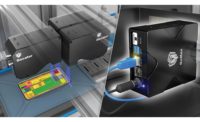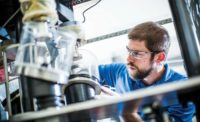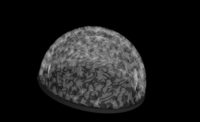The Future of 3D Printing
With the combination of CT technology and 3D printing, many new applications are possible.



Image 4. False color representation. (The difference of surface dataset of original hold croft bar and surface dataset of reproduced hold craft bar using laser sintering.)



What started as a project to investigate the accuracy and reproducibility of reverse engineering a product using computed tomography (CT) and additive manufacturing with 3D printing technology has helped to establish some guidelines and processes for the future of high-quality “3D copying.”
Back in 2010, a group of engineers and technologists from industry leading organizations including Fraunhofer EZRT, Bayerisches Laserzentrum, and Hochschule für Angewandte Wissenschaften - Fachhochschule Hof, gathered to perform an experiment to develop a proof of concept for 3D printing. The goal of this experiment was to determine the accuracy of each sub-step of the process. For the experiment, the specimen to be tested was a calibrated hold croft bar fabricated of a carbon fiber bar and ruby balls. (See Image 1. Calibrated hold croft bars are popular within the field of calibration of metrology machines and determination of measuring accuracy.)
To further investigate the theory of measurement accuracy and reproduction of an object through 3D printing and copying, the engineers and technologists set out to test not only an overall process, but a series of sub-processes as well, including two distinct portions for reproduction to take place.
The Test
It began with a simple data acquisition, utilizing a CT system to determine the voxel volume of the calibrated croft bar. During the CT scan, specialized software transforms the multi-axis image captured into a digital reconstructed 3D voxel volume view of the specimen.
There are standard tolerance capabilities of the CT which does limit the accuracy of this measuring technique. Thus it is necessary to use a well calibrated system and proper system parameters to achieve the best possible quality. However, CT is one of the most accurate and versatile imaging techniques available today.
Next, the group needed to generate the surface data of the croft bar in a stereolithography format (STL) using the marching cubes algorithm. Once the surface data was generated, the technologists employed two different additive manufacturing methods to test the reproduction of the croft bar: stereolithography (SLA), which is a technology used to create parts layer by layer, and selective laser sintering (SLS), which is a technique that uses a laser to sinteband bind powdered material in order to produce a solid structure. Each of these methods offer different positive and negative attributes to maximize the accuracy of the reproduction, and you should further investigate which method provides the best solution for your application based upon materials and size.
The surface data STL files were now used as input parameter for the manufacturing methods. The technologists went on to print 10 of the hold croft bars utilizing each method, SLA and SLS. (See Image 2 and 3.)
After manufacturing parts they determined uncertainty of measurement of both printing methods using the target vs. actual comparison of surface datasets generated with a coordinate measuring machine (used as a reference method). A coordinate measuring machine (CMM) is a device that measures the physical dimensions and attributes of an object. The measurements are determined by a probe attached to a three axis system within the machine which takes precise point data in 3D space. (See Image 4.)
Analyzing the target vs. actual coordinate measurements, it was discovered that SLS provided a higher accuracy reproduction as compared to the SLA. This can sometimes be affected by the unique attributes of each manufacturer’s printing machine.
CT technology was then used again to analyze the hold croft bars that were reproduced through each method. The 10 hold croft bars were scanned to detect and define the accuracy of the measurement capabilities of CT technology, as well as the accuracy and variability of measurement of the total process.
The Results
The findings of the experiment concluded that there are many influencing factors within the overall process that determine the quality and accuracy of CT technology and 3D copying to reverse engineer objects.
When capturing imaging and coordinate data during the CT portion of the process, it is necessary to take into account specifications such as temperature, X-ray parameters, and accessible resolution. And, during the 3D copying/reproduction stage, the material used and additive layer thickness contributes to the accuracy of the finished product. The calibration of all systems and processes are necessary to achieve adequate quality, as each sub-step affects the overall project and becomes specific to the object being reproduced.
In conclusion, the engineers and technologists were proud to report that, depending on system setup and calibrations, it is possible to achieve a reverse engineered reproduction with very high quality and less than 1% of deviations in shape, size, etc. Depending on the material used during the 3D printing process, it is possible to fabricate a sample with comparable characteristics as raw material.
The Future
The results of the performed experiment open doors to new opportunities and advancements for a multitude of companies and industries. X-ray inspection companies are leading the charge, looking to leverage their technology and processes to enhance their current product lines and deliver simplified “3D copying” solutions.
With the combination of CT technology and 3D printing to create a new “3D copying” technique, future uses like the following can be successfully achieved:
Reverse engineering of an object or product, as described in the experiment
Real-time equipment failure part reproductions
Internal component reproduction without disassembling the whole product (i.e. a piston or engine block)
Rapid prototyping to quickly fabricate samples using design data (computer aided design (CAD)
With decreasing costs and increasing ease of use of CT scanners and 3D printers, the technique of “3D copying” will become more and more established in different types of applications during the coming years.
Summary
These types of uses are sure to change the way products are analyzed, developed and repaired, eventually reducing costs and speeding up product development cycles.
Looking for a reprint of this article?
From high-res PDFs to custom plaques, order your copy today!








